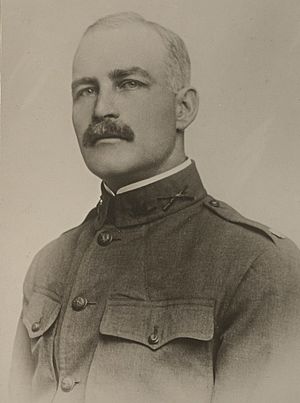Henry Root Hill facts for kids
Quick facts for kids
Henry Root Hill
|
|
|---|---|
 |
|
| Born | June 20, 1876 Quincy, Illinois |
| Died | October 16, 1918 (aged 42) Romagne-sous-Montfaucon, France |
| Buried |
Woodland Cemetery,
Quincy, Illinois |
| Allegiance | |
| Service/ |
|
| Years of service | 1894–1918 |
| Rank | |
| Unit | Illinois National Guard |
| Commands held | Provisional Regiment, Illinois National Guard 2nd Brigade, Illinois National Guard 2nd Brigade, 12th Provisional Division 65th Infantry Brigade 2nd Battalion, 128th Infantry Regiment |
| Battles/wars | Spanish–American War Pancho Villa Expedition World War I |
| Awards | Distinguished Service Cross |
Henry Root Hill (born June 20, 1876 – died October 16, 1918) was a brave United States Army officer. He served in the military during the late 1800s and early 1900s. He fought in World War I and sadly lost his life during the conflict.
Contents
Early Life in Illinois
Henry Root Hill was born in Quincy, Illinois, on June 20, 1876. His parents were Frederick T. Hill and Cecelia (Root) Hill. He went to public schools in Quincy.
Young Henry worked at his father's business, F. T. Hill Co. This company sold furniture and carpets. After his father passed away in 1905, Henry took over the family business.
Starting a Military Career
In 1894, Henry Hill joined the Illinois National Guard. He started as a private in Company F, 4th Infantry Regiment. He worked hard and moved up the ranks. He became a first sergeant in his company.
During the Spanish–American War, his unit was called to serve. They trained in Georgia. After the war ended, they returned to Illinois. In 1899, he became a second lieutenant.
Hill was promoted to captain in 1902. He commanded Company F and later worked as an adjutant (an assistant officer) for the 5th Regiment. In 1908, he became a lieutenant colonel. He was second-in-command of the 5th Regiment.
By 1914, Hill was in charge of a special regiment in the Illinois National Guard. Later that year, he was promoted to brigadier general. He commanded the 2nd Brigade of the Illinois National Guard.
In 1916, General Hill served on the U.S. border with Mexico. He was part of the Pancho Villa Expedition. He commanded the 2nd Brigade, 12th Provisional Division during this time.
Service in World War I
On July 25, 1917, Henry Hill became a brigadier general in the National Army. He led the 65th Infantry Brigade. He trained his troops in the United States and then deployed them to France.
In July 1918, General Hill was reassigned. The commander of the 33rd Division, General George Bell Jr., preferred regular army officers to lead brigades. General Hill was offered other roles, but he wanted to serve on the front lines. He chose to become a major in the Infantry on August 29, 1918.
Major Hill then commanded the 2nd Battalion, 128th Infantry Regiment. This unit was part of the 32nd Division. He fought bravely in France. Colonel Robert Bruce McCoy, who commanded the 128th Infantry, specifically asked for Major Hill. They had worked together before and McCoy admired Hill's leadership.
A Heroic Sacrifice
On October 16, 1918, Major Hill was killed in action. This happened during fierce fighting near Romagne-sous-Montfaucon, as part of the Meuse-Argonne Offensive. He had led his battalion through many enemy machine gun nests to reach their goal.
Major Hill then saw four enemy soldiers preparing to fire a machine gun at his men. He bravely charged them alone. He captured three of the German soldiers. However, the fourth soldier killed him. For his incredible bravery, he was given the Distinguished Service Cross after his death.
Burial and Legacy
Henry Root Hill was first buried in France. In 1921, his body was brought back to the United States. He was buried at Woodland Cemetery in his hometown of Quincy, Illinois. In 1930, a law was passed that allowed World War I generals to keep their highest rank. So, Henry Hill's rank of brigadier general was officially restored after his death.
Henry Hill never married and did not have children. After he died, his mother had a fountain in Quincy dedicated to his memory. The Henry Root Hill Memorial Hospital in Quincy was named after him. Also, the local American Legion post in Quincy, which helps veterans, was named the Henry R. Hill post (now called the Hill-Emery post).

